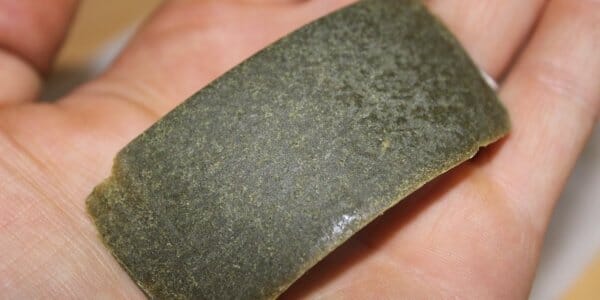
Potential Risks and Side Effects
Hashish consumption presents risks similar to unconcentrated cannabis but intensified. Although no fatalities have been documented from hashish consumption, it is crucial to consume it in moderation and with caution to avoid unwanted side effects. Possible side effects include confusion, paranoia, increased appetite, impaired motor control, changes in heart rate, red eyes, dry mouth, among others. Consulting with a doctor before recreational hashish consumption is essential to ensure a safe experience.
Preparation:
Different methods have been employed over time for the preparation of hashish, from ancient practices such as rubbing fresh flowers or dry sieving to more modern methods such as ice and water separation, dry ice, static electricity, heat and pressure, and acoustic vibrations, aiming to obtain a purer product.
A study conducted by Jean-Jaques Filippi, Mariel Marchini, Céline Charvoz, Laurence Dujourdy, and Nicolas Baldovini in 2014 linked the distinctive flavor of hashish with a alteration of myrcene during its manufacturing process.
Legality and quality:
The legality of cannabis has been the subject of debate and controversy for decades worldwide. Almost all countries have laws related to its cultivation, possession, sale, and consumption. While non-psychoactive products such as fiber and seeds are legal in many places, those with high THC content are considered controlled substances in most countries, with exceptions for medicinal use. Arguments have been made for changes in its regulation due to the perceived failure of prohibitionist and law enforcement policies.
The quality of hashish can vary considerably and can be determined by various indicators. Smell is one of the main ones, with high-quality hashish having a fragrant and aromatic aroma, while low-quality hashish may have a stale or moldy odor. Sticky consistency may indicate the addition of oils to increase the weight of the product, while a greener interior color may suggest a higher content of plant material.
Hashish, also known as hash or chocolate due to its characteristic brown color, produces psychotropic effects similar to marijuana but with additional cognitive impacts. Effects can be both short and long term and include sensory distortion, poor coordination, difficulty breathing, anxiety, dry mouth, and eye irritation. Excessive consumption can result in intoxication, with symptoms such as panic attacks, vomiting, and tachycardia. Prolonged consumption can have harmful and dangerous effects, such as memory loss, concentration, and lung damage.
- SEO Powered Content & PR Distribution. Get Amplified Today.
- PlatoData.Network Vertical Generative Ai. Empower Yourself. Access Here.
- PlatoAiStream. Web3 Intelligence. Knowledge Amplified. Access Here.
- PlatoESG. Carbon, CleanTech, Energy, Environment, Solar, Waste Management. Access Here.
- PlatoHealth. Biotech and Clinical Trials Intelligence. Access Here.
- Source: https://amsterdammarijuanaseeds.com/blog/post/hashish-tradition-science-explained
- :has
- :is
- 2014
- a
- addition
- Additional
- Aiming
- All
- almost
- also
- Although
- among
- Ancient
- and
- Anxiety
- appetite
- ARE
- arguments
- AS
- Attacks
- avoid
- BE
- been
- before
- both
- breathing
- brown
- but
- by
- CAN
- cannabis
- caution
- Changes
- characteristic
- Chocolate
- cognitive
- color
- Concentrates
- concentration
- conducted
- confusion
- considerably
- considered
- consistency
- consulting
- consume
- consumption
- content
- control
- controlled
- controversy
- coordination
- countries
- crucial
- cultivation
- damage
- Dangerous
- debate
- decades
- determined
- Difficulty
- distinctive
- distortion
- Doctor
- documented
- dry
- due
- during
- effects
- electricity
- employed
- enforcement
- ensure
- essential
- excessive
- experience
- explained
- eye
- Eyes
- Failure
- fatalities
- flavor
- For
- fresh
- from
- greener
- harmful
- hash
- Have
- having
- Heart
- High
- high-quality
- higher
- HTTPS
- ICE
- Impacts
- in
- include
- Increase
- increased
- indicate
- Indicators
- intensified
- interior
- IT
- ITS
- jpg
- known
- Law
- law enforcement
- Laws
- Legal
- linked
- Long
- loss
- made
- Main
- manufacturing
- many
- marijuana
- material
- May..
- medicinal
- Meets
- Memory
- methods
- moderation
- Modern
- more
- most
- Motor
- mouth
- Nicolas
- no
- non-psychoactive
- obtain
- of
- oils
- ONE
- ones
- or
- Others
- over
- Panic
- perceived
- Places
- plant
- plato
- Plato Data Intelligence
- PlatoData
- policies
- poor
- possession
- possible
- practices
- preparation
- presents
- pressure
- process
- produces
- Product
- Products
- quality
- Rate
- Recreational
- Red
- Regulation
- related
- result
- risks
- safe
- sale
- Science
- seeds
- Short
- side
- similar
- Smell
- static
- sticky
- Study
- subject
- such
- suggest
- Symptoms
- term
- THC
- The
- those
- time
- to
- tradition
- unwanted
- use
- various
- vary
- Water
- weight
- while
- with
- worldwide
- zephyrnet





